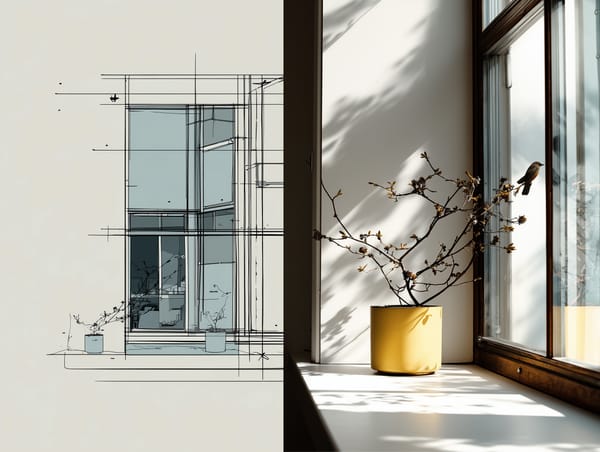When People Know Your Work, You Skip the Queue
"When people know your work, you move from competing for opportunities to being chosen for them."

You open a job post. It asks for a portfolio, three references, a cover letter, and availability for a long interview process. You spend hours tailoring everything. You click submit and join a queue of hundreds of designers waiting for someone to notice them.
Then a friend messages you.
“I mentioned your work to their director. She wants a call on Tuesday.”
No application.
No competition.
No queue.
This is the gap between being qualified and being known. For creative professionals, understanding this gap changes how you build your career.
The Hidden Economy of Recognition
Two markets run at the same time.
The visible market is what everyone sees. Job boards. Applications. Proposal forms. Filters and keywords. Large numbers of people competing for the same opportunity. This is the queue.
The second market is harder to see but holds most of the high-value opportunities. Someone needs a designer and thinks of you immediately. A client reaches out before posting publicly. A weak brief turns into a direct message instead of a formal search.
This market runs on recognition, not paperwork.
Early-career creatives spend most of their time in the visible market because it is the only one they understand. They polish documents. They apply widely. They wait. They get rejected. Then they repeat the loop.
More established creatives operate in the second market. They are not better. They are better known.
Talent alone does not move you out of the queue. Recognition does.
Why Recognition Beats Credentials
When someone knows your work, the hiring process changes. They are not comparing you to anyone. They are not scoring you against a checklist. They already trust you. They reach out because they want you specifically.
In the queue, you try to prove your value.
When people know your work, they already believe it.
In the queue, price becomes a factor.
When people know your work, value becomes the focus.
In the queue, you become an option.
When people know your work, you become the answer.
Recognition answers the questions that interviews try to uncover. It signals reliability, judgement, and consistency. A degree shows that you studied. A portfolio shows you can produce. Recognition shows people trust your output.
Think about how you hire. When you need help, you ask someone you trust instead of searching the entire market. Creative teams behave the same way.
The Compounding Effect of Visibility
Recognition grows each time someone sees your work. Qualifications do not. Degrees stay static. Training stays static. Visibility grows.
Every case study.
Every published project.
Every clear breakdown.
Every consistent post.
Every useful insight.
All of it builds recognition. Each piece creates another reference point in someone’s mind.
Two designers with equal skill will not have equal careers. The one who shares their work, documents their thinking, and stays visible gains opportunities first. The one who works quietly stays dependent on queues.
Recognition is slow to build, then fast to reward. What looks sudden is usually the result of consistent visibility over time.
Strategic Visibility Beats Noise
Being visible is not enough. Plenty of people are visible without being remembered. Recognition comes from targeted visibility. You show the right work to the right people in the right places.
Focus on four things.
Be Known for Something Specific
General labels put you in large queues.
Clear focus places you in smaller, higher-value lanes.
Specific work is easier to remember.
When someone needs that specific work, you come to mind immediately.
Go Deep Where It Matters
Posting everywhere creates noise.
Showing up consistently in a small number of relevant places creates recognition.
Pick one or two platforms.
Show up with purpose.
Stay consistent.
Share Your Thinking
Finished work is easy to scroll past.
Insight is harder to ignore.
Explain why you made decisions.
Explain how you solved problems.
Explain what constraints shaped the project.
People remember the creative who teaches.
Make Personal Work
Some of your most valuable recognition will come from projects you made without a client. Personal work shows your taste, your judgement, and your point of view. It is unfiltered. It is clear. It is yours.
The work people remember is often the work you made for yourself.
The Long-Term View
Recognition takes time to build. That is why many creatives avoid the process. They want fast results. Recognition delivers slow results that grow into long-term value.
In year one, you publish work and get little feedback. You share your process. You talk about your ideas. You enter conversations. It feels like nothing is moving.
In year two, people start remembering your name. Someone reaches out with a small opportunity. Someone else refers you. A client mentions a project you posted months ago.
In year three, recognition accelerates. You receive unsolicited enquiries. You join projects without applying. People know your lane and associate you with it.
By year five, most of your work comes from recognition. You get referrals, repeat clients, and direct contact from people who already trust your skills. You spend less time competing and more time creating.
The timeline feels slow. But that time passes anyway. The question is whether you spend it competing for attention or building a reputation that brings attention to you.
Build Recognition Today
Start with a simple audit. If someone in your ideal audience had a problem you can solve, would they think of you? If not, identify the gaps.
Pick one publishing channel. Stay consistent. Weekly breakdowns. Project updates. Simple studies. Short insights. You do not need high volume. You need reliability.
Be generous. Share others’ work. Add useful comments. Support people in your space. Recognition grows through contribution, not self-promotion.
Document your progress honestly. Share mistakes. Share lessons. Share improvements. People connect with clarity more than perfection.
Beyond the Queue
Queues are part of early creative careers. They help you gain experience. They expand your skills. But they are not a place to stay. If you rely on queues after several years in the industry, your recognition strategy needs attention.
Your goal is simple. Move from unknown to known.
From competing to being selected.
From applying to being invited.
This shift does not happen by accident. It happens through consistent visibility, steady improvement, and a portfolio that stays in circulation.
Your work deserves to be seen by the people who value it. They cannot value it if they never see it.
Start building recognition now.
The queue will still be there.
You will use it less and less.
✉️ Every other Sunday I share short, honest reflections on creativity & freelancing: Read the newsletter →



